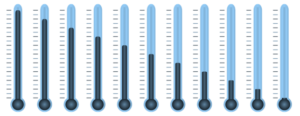7/9/2022
The energy crisis has brought up questions about saving heat in paint shops. The prices of electricity, gas, oil, pellets, etc. heat sources have increased significantly and availability has also fallen. Can the temperature be lowered in paint shops? What should be considered in painting process? Juhani Korajoki from Nor-Maali’s Technical Service tells how colder painting conditions affect to the production process and what shall be taken into account.
Traditional industrial coatings can be painted even in colder conditions, as long as the requirements brought by the laws of physics are taken into account. “Finnish engineering industry has been painting in colder conditions throughout the history. Painting usually goes well when you know how to be prepared for changing environmental conditions, though from time to time there are also setbacks”, says Juhani Korajoki, Technical Service Manager.
In September, the nights are already starting to get cold. At the same time, lightly insulated paint shops start to cool down. “In the technical service, you can tell the arrival of autumn by frequent calls about reasons why there is tackiness of the surfaces in an object painted during the previous day”, says Juhani. “This phenomenon is most commonly caused by low temperature and high humidity”, he explains.
Temperature and relative air humidity go hand in hand. The colder the air, the less moisture it can hold. When the air humidity gets too high the volatile components of the coating cannot evaporate from the paint film due to the surrounding air been saturated with moisture. Technical data sheets identify the maximum air humidity at which the coating still dries. For the solvent-based coatings, this limit is usually 80% and for the water-borne coatings it is a little less.
The dew point is the temperature at which water vapor begins to condense. In this case, the relative humidity is 100% and the air is completely saturated. The following rule shall be used as a general guideline: steel can be painted if the surface temperature is min. 3°C above the dew point of the air.
“Application conditions may change with a very fast cycle. The temperature and the humidity shall be within the limits specified in the technical data sheets throughout the spraying process. A continuous monitoring of temperatures, air humidity and dew point must also be a part of a high-quality painting process, especially in colder temperatures”, Juhani advises.

”Can you paint in the cold?”
The drying and curing processes of most two-component coatings are temperature-dependent reactions. The lower the temperature, the longer it takes for the coating to dry and cure. In the industrial painting process, essential time values are minimum dry to over coat and practical packability.
The technical data sheet of Jotacote Universal N10 mentions the drying times at different temperatures as follows:
| Substrate temperature | -10°C | -5°C | 0°C | +5°C | +10°C | +23°C | +40°C |
| Surface (touch) dry | 26 h | 14 h | 10 h | 6 h | 5 h | 2 h | 1 h |
| Walk-on-dry | 72 h | 34 h | 24 h | 14 h | 10 h | 5 h | 2 h |
| Dry to over coat, minimum | 36 h | 22 h | 15 h | 9 h | 7 h | 4 h | 2 h |
| Dried/cured for immersion | 14 d | 7 d | 4 d | 3 d | 2 d | 1 d | 12 h |
Jotun´s Jotacote Universal N10 can be overcoated at +40°C in 2 hours (min.), while at -10°C in 36 hours (min.). The difference is considerable. With lower painting hall temperature longer time must be reserved for the painting process. “If the temperature is dropped from room temperature to +10°C, the lead time of the painting process at least doubles”, states Juhani.
Even if the temperature of the paint shop and the surface of the object to be painted is lowered, it would still be good to keep the paint temperature at least +20°C. If the temperature of the paint decreases, it becomes stiffer as the viscosity increases. Stiffer coating, on the other hand, makes painting more difficult when the spraying properties change.
In order to make the spray fan better, the coating has to be thinned. Thinning requirement for cold coating is bigger than for warm coating. Over-thinning may result in paint saggings when the coating heats up during use. With over-thinned paint, the desired film thickness is also more difficult to achieve.
Paint products differ from each other, including their application temperatures. The use of many products is restricted when the temperature drops down to +10°C or below. Nor-Maali’s coating selection includes, for example, the following products for cold temperatures:
| Product | Product description | Minimum drying temperature |
| NorECOat FD Primer | epoxy primer | -5°C |
| NorECOat HS Primer | epoxy primer | +5°C |
| Norepox HS | epoxy topcoat / direct-to-metal coating | +5°C |
| Normadur 65 HS | polyurethane topcoat / direct-to-metal coating | -5°C |
| Normafine 40 HS | polyurethane topcoat / direct-to-metal coating | 0°C |
| Normastic 405 WG | high build epoxy coating | -5°C |
| Penguard Express | epoxy primer | -5°C |
| Jotacote Universal N10 | high build epoxy coating | -10°C |
| Hardtop XPF | polyurethane topcoat | -10°C |
The coatings supplied by Nor-Maali Oy have been sprayed in colder temperatures for a long time. Reference sites can be found, for example, in shipyards, repair yards, bridge projects and many other outdoor sites where environmental conditions cannot be adjusted. “At outdoor locations, the environmental conditions may impose restrictions for the painting, but constant monitoring of air humidity, temperature and dew point, as well as professional product knowledge make it possible to spray even in the most challenging conditions. You have to know the products to know if the environmental conditions allow you to paint“, says Juhani.
With the right choice of coating and production flexibility, the painting process can also be carried out in colder temperatures.
Paint shops can be converted to consume less energy by lowering the temperature. Having said that, since every painting facility is different from other, a focal point is to do it in a controlled manner. In our technical data sheets (TDS) we provide the information of the drying times, required conditions and restrictions. These lay down a good starting point for controlling the intended plan to lower the temperature in a paint hall. The given TDS information provides guidelines to be followed. A continuous monitoring of air temperature, object’s surface temperature, air humidity and dew point is needed in order to ensure high quality output. In any case, painting in the colder conditions is a longer process, and this should be taken into account, when planning the production throughput.
With the right choice of product, application can be carried out also in a colder temperature. However, in such conditions spraying properties tend to change, typically the spray fan. “As a guideline the paint should be kept warm, even if the paint shop is cooler”, says Juhani.
As always, the occupational safety measures and the environment, must be taken into account also when painting in a colder temperature. Personal protective equipment and a good ventilation are an important part of a high-quality painting process”, Juhani reminds.
If any question, please contact Nor-Maali’s Technical Service.

Juhani Korajoki, head of Nor-Maali’s Technical Service, explains how lowering the temperature affects the painting process.